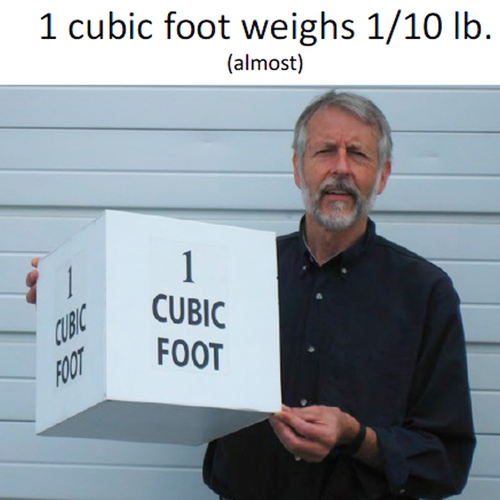
Image Credit: Martin Holladay
For the past 17 years, Joe Lstiburek and Betsy Pettit have hosted an annual conference, the Westford Symposium on Building Science, near their home in Massachusetts. Informally known as “summer camp,” the invitation-only gathering attracts hundreds of builders, engineers, architects, professors, and building science researchers.
The attendees listen to presentations at a conference center during the day and relax in Joe and Betsy’s backyard during the evening.
This year’s conference was held on August 5-7. Speakers included Michael Blasnik, Mike Steffan, Gary Klein, Kent Browning, Achilles Karagiozis, Chris Schumacher, Dave Ober, Joerg Birkelback, Marcy Tyler, Ed Retzbach, Andreas Holm, and Joe Lstiburek.
Covering familiar territory
If there were any devoted readers of GBA at the conference, they probably recognized the information provided at several of the summer camp presentations this year. At the Westford conference, Blasnik discussed the limitations of energy modeling software, a topic covered in a GBA blog published in March 2012. Blasnik also discussed bad energy retrofit advice, a topic which GBA has covered in at least three articles: A Plague of Bad Energy-Saving Tips, More Energy Myths, and How Not to Save Energy.
(The PowerPoint slides that Blasnik used in his presentation can be viewed by clicking one of the links at this Web page. The page also includes links to some of the other presentations from this year’s Symposium.)
Gary Klein, a renowned expert on domestic hot water systems, discussed several ways to reduce the time required for hot water to travel from a water heater to a faucet. GBA has reported on Klein’s calculations and advice in several articles, including Inefficient Hot Water Piping Layouts Waste Hot Water and All About Water Heaters.
Joe Lstiburek’s presentation focused on his proposal that ASHRAE 62.2 be replaced with a new residential ventilation standard. His…
Weekly Newsletter
Get building science and energy efficiency advice, plus special offers, in your inbox.

This article is only available to GBA Prime Members
Sign up for a free trial and get instant access to this article as well as GBA’s complete library of premium articles and construction details.
Start Free TrialAlready a member? Log in















12 Comments
quick clairifcation
I didn't actually mean that you should adjust the insulation R value by 20% (i.e. multiply by 0.8) -- I meant that you should reduce your estimated energy impact from infiltration by 20%. You should leave the conduction estimate alone.
I completely disagree with describing this interaction as air leakage reducing the performance of insulation. The actual impact is the opposite -- air leakage improves the performance of insulation. It's just that the air leakage itself adds more to your loads than it reduces the conduction losses. Put another way, if you calculate the conduction losses and infiltration losses separately using standard methods, you end up over-stating the combined heat loss that would occur if the air flows through insulation or building cavities.
Response to Michael Blasnik
Michael,
Thanks for your comments; I have edited my article to reflect your useful feedback. I'm sorry that I misinterpreted your "multiply by .8" comment.
I understand that air infiltration reduces the conduction losses though air-permeable insulation, and have discussed the phenomenon in several recent articles, including Air Leakage Degrades the Thermal Performance of Walls and Energy Modeling Isn’t Very Accurate. You're quite right, of course, that my phrasing was sloppy when I wrote that "air leakage reduces the performance of insulation."
Thanks for keeping me on my toes.
Why Are Savings Overestimated? REALLY?!
When my Quickbooks balance and my bank balance don't match, I don't blame the software. If I don't journal a deposit or withdrawal, the inaccuracy is my fault. Blaming Intuit seems a bit absurd.
To use a golf analogy for modeling, I think everyone would agree accuracy is landing on the green. Landing in the hole is not required, particularly when current shots are landing on the fairway of the adjoining hole. The fault does not lie with the club, it lies with the player and the game.
That models overstate consumption initially should be no more surprising than the fact a reasonably ACCURATE Manual J oversizes equipment by as much as 30%. It's the fudge, Kaptain Krunch!
Why Are Savings Overestimated? REALLY?!
Looking over Michael Blasnik's presentation I kept hoping to see these possibly controversial proposed answers in the "Why Are Savings Overestimated" slides:
"Because there is no incentive for accuracy and a lot of disincentive" or
"Because there is no reconciliation step" or
"Because bigger savings are easier to sell than smaller savings" or
"Because EE programs require COST EFFECTIVENESS at project level, and the less you exaggerate savings, the fewer jobs you will get approved" or
"Because savings are never tracked, reported to the consumer or contractor, or otherwise made public." or
"Because you can not expect accuracy without measurement, feedback, and incentive."
(Not that there was NO beef for me in the slides, I did enjoy much of the content. I loved the debunk of "takeback" and studies indicating that people don't suddenly keep improved homes at 80°, and the "free energy advice Overpriced?" I do think the fact "Movers" energy consumption went up vs "Stayers" might have correlation to drop in energy prices.)
OK, I understand that such direct call out against bad program design could lead to unpleasant repercussions, and possible uncertainty of future employment. As one friend recently told me when discussing publicly calling out issues some might be embarrassed by - "I've got to WORK with these people". And I get a lot of "I'm glad you are doing this, but I've got a family to support..."
Which prompts this concluding question - Is there anybody in a position of influence who is willing to put truth in front of self-preservation?
Response to Ted Kidd
Ted,
I can assure you that Blasnik considered the factors you proposed. Looking back on my notes, I found that Blasnik noted in Westford, "There are problems with data collection and auditing problems. They look at your attic. The form asks, 'What is the R-value of this attic insulation?' There is a bias toward assuming the existing insulation is bad."
He mentioned that there are many utility-sponsored programs where auditors miraculously find a great many houses that are just bad enough to meet the threshold required to participate in the program.
The last time I heard Michael give this presentation (in 2012), I wrote an article called Energy Modeling Isn’t Very Accurate. In that article, I wrote, "Many models ask for inputs which are open to interpretation. Blasnik asked, 'How do you decide if a basement is conditioned or unconditioned? Perhaps it’s semi-conditioned? Or unintentionally conditioned? Or maybe unintentionally semi-unconditioned?' When making these types of assessments, it’s hard for technicians to avoid unintentional bias. Technicians entering pre-retrofit information on an older home often come up with pessimistic R-value estimates for existing insulation levels, leading to overestimated savings projections. Because of these problems with input accuracy, default assumptions are often more accurate than data collection."
If these types of data-entry errors can be shown to be consistent, then they need to be considered by the developers of the model. If default values are more accurate than inputs by auditors, then software developers who fail to change their models are promoting bad models.
Rain screen gaps
Martin,
Great re-cap on the symposium. I'm sure it was great being around the "brethren" complete with music and a bar!
I did not see where Achilles slides were available. I'm really interested in hearing more on his presentation on rainscreens. It makes great sense that solar drive is the chief mechanism that creates airflow. With today's thicker walls and higher moisture loads did he present any specifics on assmbally values of R36 and above?
I keep encountering the old idea of "all you need is a gap wider than the surface tension of water" idea. This usually means something in the range of 1/8 - 1/4". This seems like a poor definition of a layer that is to relieve moisture load by evaporation enabled by air flow.
It would be great if you we're able to recall if he cited a gap value or thickness based on a wall type or thickness, and if that was tied to a particular climate. It's a really interesting subject to me since I still like the "high drying potential to the exterior" assemblies that use high perm sheathing like the Agepan that we use, or something similar like Doug McEvers favorite North American fibre board that he's sourced.
It becomes interesting to consider that from Achilles's "WUFI perspective", perhaps a larger gap is less useful over plywood at around 1 to 1.5 perms since it may not allow enough diffusion to feed airflow created. And... at what point does the wall potentially diffuse more that the airflow can evaporate?
This is a round about way of asking: is one way of "sizing" the rain screen gap based on how permeable the exterior layers are? It sure makes sense to me that these values are interrelated.
Domestic Hot Water and Gary Klein
Gary's Structured Plumbing strategy is the most efficient way to plumb a new house. It reduces the wait time for hot water, and saves a lot of energy without adding cost.
I don't see many builders promoting the concept, maybe because it takes a few minutes to understand, and some of the concepts are tricky (like longer runs of smaller pipe).
Michael Chandler's sketch makes it easier to grasp for a residence, so I wrote this article: http://greenbuildingindenver.blogspot.com/2012/07/plumbing-efficiency-in-new-construction.html
About that attic ventilation
Blasnik said among other things, “If you have a vented attic, most of the ventilation air isn’t coming from the soffit vents. Most of the ventilation air comes from the house to the attic, and then out.”
Somewhere there probably is a study which documents this. I would like to see that study if possible. My expectation is the houses in the study, have some qualities where I can pursue the opposite.
Response to Albert Rooks (Comment #6)
Albert,
You wrote, "I did not see where Achilles' slides were available." You're right -- they haven't been posted (yet).
Q. "With today's thicker walls and higher moisture loads, did he present any specifics on assembly values of R-36 and above?"
A. Not specifically. However, Karagiozis mentioned that today's high-R walls are subjected to higher moisture loads and have less drying potential than older low-R walls. Therefore, he said, it's important to provide designs that maximize drying -- if only to provide an extra safety factor to cover workmanship defects.
Q. "I keep encountering the old idea of 'all you need is a gap wider than the surface tension of water' idea. This usually means something in the range of 1/8 - 1/4 inch. This seems like a poor definition of a layer that is to relieve moisture load by evaporation enabled by air flow."
A. As I wrote in my article All About Rainscreens, a rainscreen gap provides many functions. Even when the gap is not optimized for ventilation drying, it is still valuable. However, increasing the gap size from 1/8 inch (a depth which, frankly, is hard to maintain consistently on a job site using wood-based materials) to 3/4 inch, and making sure that the gap has ventilation openings at the top as well as the bottom, greatly increases the drying rate. So if you care about ventilation drying rate, you want the gap to be big enough, and you want openings at top and bottom.
Q. "At what point does the wall potentially diffuse more that the airflow can evaporate?"
A. If you have a decent air barrier, you're stopping the most important moisture transport mechanism. Diffusion is a minor concern, unless you have an indoor swimming pool or a very humid greenhouse filled with tropical plants.
Q. "This is a roundabout way of asking: is one way of 'sizing' the rainscreen gap based on how permeable the exterior layers are?"
A. Using vapor-permeable sheathing is a double-edged sword, because of the problem of inward solar vapor drive. In many cases, walls with vapor-impermeable sheathing (especially rigid foam of an adequate thickness) stay dryer than walls with vapor-permeable sheathing. Interestingly, Karagiozis is a big fan of Delta-Dry, an impermeable plastic product with egg-carton dimples. Delta-Dry creates two distinct air gaps: one between the siding and the Delta-Dry, and one between the Delta-Dry and the sheathing. Karagiozis says that Delta-Dry performs phenomenally well -- partly because it takes advantage of ventilation drying, and partly because it is vapor-impermeable (and therefore stops inward solar vapor drive).
I will post a photo of Delta-Dry below. For more information on Delta-Dry, see All About Water-Resistive Barriers.
.
Response to Kevin Dickson (Comment #7)
Kevin,
Thanks for the link to your blog; I'm glad to hear that you found Michael Chandler's sketch to be helpful.
For more information on Gary Klein's approach to piping hot water systems, see my article, All About Water Heaters.
For still more information, here is a link to a Web page with links to four articles by Gary Klein. Klein's articles address his approach in depth.
Response to Mark Johnson (Comment #8)
Mark,
Michael Blasnik is a smart guy, with a background in weatherization work as well as number-crunching. While I'm sure that he is right about air leakage through ceilings in existing houses, his description does not apply to a new home that is built with attention to airtightness.
I'm not sure whether he was thinking of a specific study when he made the comment; but any weatherization contractor with blower-door experience can testify that the ceilings in old homes tend to be incredibly leaky.
If you want to build an unconditioned vented attic that works well, your task is not too complicated. Pay attention to airtightness when building your house. Don't install any recessed can fixtures in an insulated ceiling. Seal the cracks between partition top plates and partition drywall. Seal all penetrations through the ceiling, including electrical penetrations and plumbing vents. Don't install any ductwork in your attic. Seal all chases and chimneys. Carefully weatherstrip your attic hatch, and make sure the hatch has a tight latch.
Finally, use a blower door and a smoke pencil to verify that your ceiling is tight.
Response to Mark Johnson
Mark- I don't think that quote is completely accurate or perhaps I misspoke. I meant to say that in many homes the stack effect pushes more air out through an attic than the vents let in. This is what I found studying old leaky flat roof rowhouses in Philadelphia (admittedly an unusual housing type) and it's also consistent with work elsewhere when you look at tracer gas measurements and driving forces in older leaky homes.
In many homes, the ceiling plane is leaky and so the stack effect is pushing lots of air 24x7 while wind induced ventilation is often intermittent and low in typically well shielded homes. But a tight ceiling completely changes this conclusion -- as would a very windy site or high levels of venting with a fairly windy site.
In "good" homes the attic ventilation will be dominated by outside air coming through the vents.
Log in or become a member to post a comment.
Sign up Log in